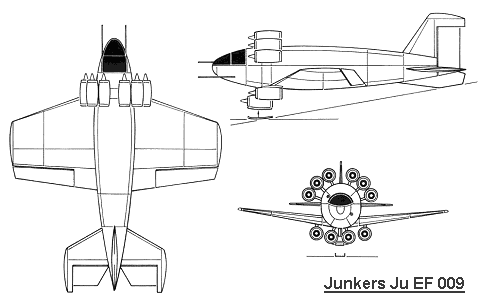 This unusual design dates from the late 1930s, and was one of a number
of early jet aircraft designs from Junkers. It was officially known as
the Hubjäger.
This unusual design dates from the late 1930s, and was one of a number
of early jet aircraft designs from Junkers. It was officially known as
the Hubjäger.
The fuselage was short and cigar-shaped, and a conventional tail unit was fitted to the rear. Wide, short wings were mounted low on the fuselage, and contained the entire fuel supply for approximately six minutes of flight. Ten small jet engines were clustered around the fuselage at the wing's leading edge, six on top and four beneath. Takeoff was to be achieved by either a takeoff trolley, or in a vertical position at 77 km/h (48 mph). It would then transition to horizontal flight when its operational altitude was reached. To help cope with the expected high G forces on takeoff, the pilot lay in a prone position. Landing was to be unpowered (that is, gliding in after the fuel was exhausted) on a central skid located between the two lower most turbojets. Armament was to consist of two MG 151/20 20mm cannon, or alternately two MK 108 30mm cannon.
Since the endurance was so short, the EF 009 would have been deployed around strategic locations as a "point-defense" interceptor. Aircraft design advances made this project obsolete almost before the ink was dry on the drawings.